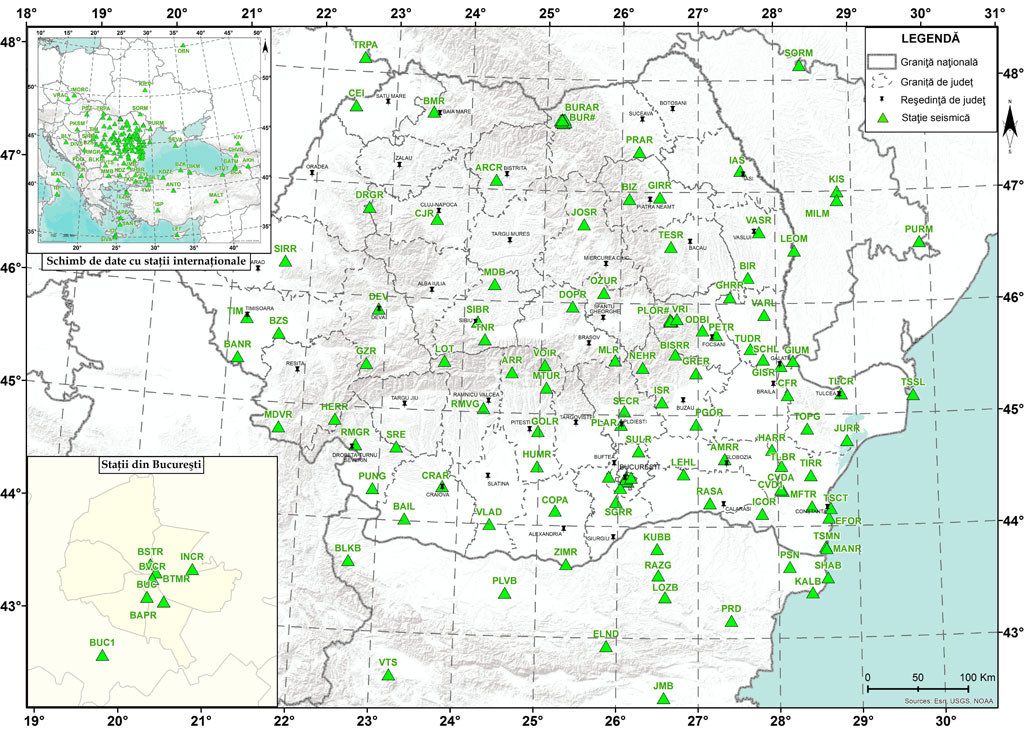SEISMIC NETWORK
National Institute for Earth Physics (NIEP) ensures the seismological monitoring of the Romanian territory through the Romanian Seismic Network (RSN), contributing directly to the seismic risk mitigation in the regions affected by strong earthquakes produced in the main seismogenic zones. Therefore, design and development of the RSN are very important tasks to implement reliable strategies for reducing of the negative impact of earthquakes. Presently, the seismic and strong motion networks consists of:
- 121 real-time seismic stations
- 147 strong ground motion stations
Two seismic arrays are presently operating, one in Bucovina (BURAR array consists of 9 short period, one BB borehole sensors and 3 BB surface sensors), and the other in Ploştina (PLOR) since 2007. Presently, PLOR array, located in the Vrancea region, consists of 7 seismic sites (3C broad-band instruments and accelerometers). Moreover, starting with 2009, an infrasonic array was designed and deployed at Ploştina (IPLOR) in collocation with the sites of PLOR seismic array. Currently IPLOR, consists from 6 infrasound instruments.

Fig. 1. Seismic network operated by the National Institute for Earth Physics. The continuous digital data of the seismic stations are analyzed in real time by the automated system for data acquisition and processing (Antelope). The Antelope system performs real-time event detection, discrimination between local and teleseismic events, automatic P and S waves picking, location and magnitude determination for local events and teleseismic.
Analyst revised bulletins are distributed to the international data centers on a regular basis (monthly), and in few hours after the occurrence of a local event with a magnitude larger than 3.5 Richter. The Romanian Seismic Network distributes its results (locations and phase data), by Internet, to several seismological services in Europe (European-Mediterranean Seismological Center; Swiss Seismological Service, Zurich; International Seismological Center, U.K.; Seismological Survey of Serbia; Institute of the Physics of the Earth, Obninsk, Russia; Institute of Geophysics, Ukraine; Geophysical Institute, Bulgaria) and USA (National Earthquake Information Center, United States Geological Survey) to be used for international seismic catalogue.
Seismic data (broad-band, strong motion) are openly provided in real time through via NIEP EIDA node and in real time trough NIEP data center or partners. The seismic real-time early warning implementation for industrial entities and installations of national interest in case of strong earthquakes is one of the latest and most outstanding achievements of NIEP that have to be mentioned.
Seismic productsThe seismo-acoustic data recorded with RSN are continuously processed by analysts in order to identify the seismic events produced in Romania and adjacent regions. For these events, an accurate location is generated and magnitude and local intensities are estimated. Specific activities are carried out for data processing and analysis of the seismic events parameters:
- waveform processing in order to extract the earthquakes parameters
- elaboration of the specific products: reviewed event bulletins, lists containing the identified seismic phases- interpretation of the earthquakes’ parameters depending on characteristics of the seismogenic epicentral zone RSN data processing and analysis provide the reliable information for the seismic hazard assessment, elaboration of the maps of macroseismic intensities, vulnerability and seismic risk, seismic early warning and macrozonation of the Romanian territory. The concrete results of the seismological monitoring with RSN consist of:
- data bank containing digital recordings of the local, regional and teleseismic events
- up-to-date seismic catalogue of the earthquakes located in Romania and neighborhood areas
- generation of ShakeMaps (near-real-time maps of ground motion and shaking intensity following significant earthquakes)
- real-time seismic early warning system for industrial units with high seismic risk to strong Vrancea earthquakes
Exchange of seismic parameters and information with other CTSPs, TSPs and NTWCs The National Institute for Earth Physics (NIEP), in collaboration with other institutions of Romania, is acting to strengthen the cooperation and data exchanges with the Black Sea surrounding countries. The data exchange with the Black Sea countries involves the acquisition of real-time data for 17 stations from Bulgaria, Turkey, Georgia and Ukraine. This improves the capability of the Romanian Seismic Network to monitor and more accurately locate the earthquakes occurring in the Black Sea area.
 Fig 1.1 Black sea seismic data exchange.
Fig 1.1 Black sea seismic data exchange.